DESCRIPTION
When the engine switch cannot be turned on (ACC) or on (IG), interior verification may be abnormal or there may be a malfunction in the ACC relay or IG relay circuit. If interior verification cannot be performed, the certification ECU (smart key ECU assembly) may be malfunctioning or communication may not be possible between the No. 1 indoor electrical key antenna assembly (front floor) or No. 1 indoor electrical key antenna assembly (rear floor) and the electrical key transmitter sub-assembly and door control receiver.
When an electrical key transmitter sub-assembly is brought into the cabin, its key ID code is compared with the key ID code stored in the certification ECU (smart key ECU assembly). If these codes do not match, key verification will fail and the engine switch will not be able to be turned on (ACC) or on (IG).
When a door is unlocked and an electrical key transmitter sub-assembly is brought into the cabin, the certification ECU (smart key ECU assembly) activates the indoor electrical key antenna assemblies to form the interior detection area. The electrical key transmitter sub-assembly then responds to the detection signals with its key ID code. This response signal is received by the door control receiver and sent to the certification ECU (smart key ECU assembly).
Related Data List and Active Test Items|
Problem Symptom | Data List and Active Test |
|---|---|
|
Power source mode does not change to on (IG) or on (ACC) | Power Source Control
|
WIRING DIAGRAM
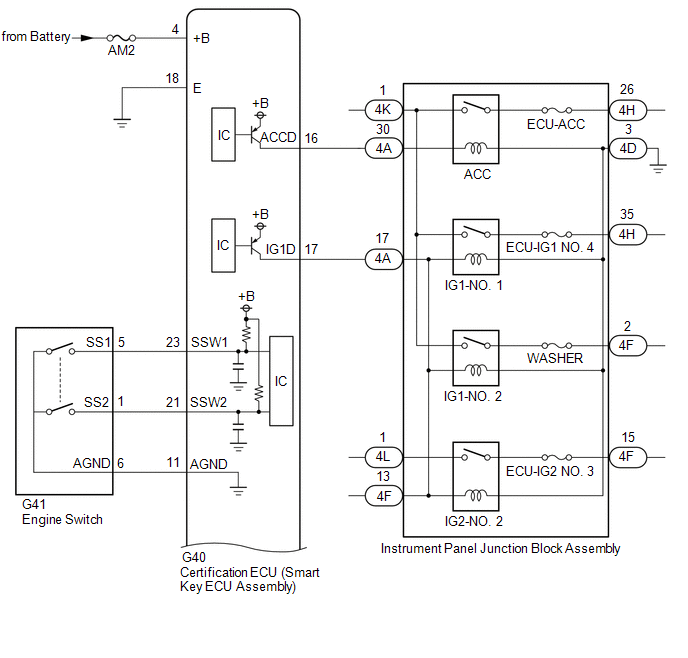
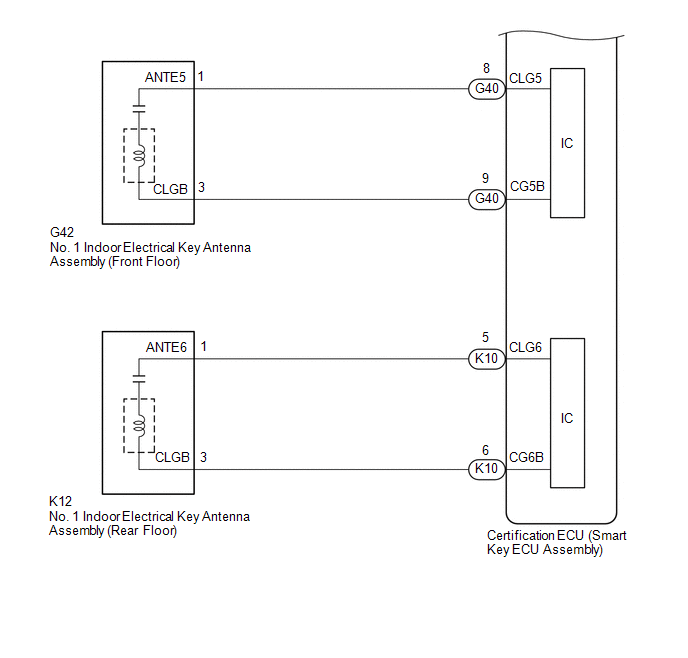
CAUTION / NOTICE / HINT
NOTICE:
Click here 
Click here 
Click here 
HINT:
|
Tester Display |
|---|
| Operation History |
PROCEDURE
| 1. |
CHECK POWER SOURCE MODE |
(a) Get into the vehicle while carrying the electrical key transmitter sub-assembly that has already been registered.
(b) Move the shift lever to P.
(c) Press the engine switch with the brake pedal released and check that the power source mode changes.
Click here 
|
Result | Proceed to |
|---|---|
|
Power source mode can only be changed when electrical key transmitter sub-assembly is in push button start function operation range for rear side | A |
|
Power source mode can only be changed when electrical key transmitter sub-assembly is in push button start function operation range for front side | B |
|
Power source mode cannot be changed |
C |
| B |
 | GO TO STEP 6 |
| C |
 | GO TO STEP 10 |
|
| 2. |
CHECK WAVE ENVIRONMENT |
(a) Install the transmitter battery to the electrical key transmitter sub-assembly.
Click here 
(b) Bring the electrical key transmitter sub-assembly near the No. 1 indoor electrical key antenna assembly (front floor) and perform an smart key system check.
Click here 
NOTICE:
Communication may not be possible if the electrical key transmitter sub-assembly is within 0.2 m (0.656 ft.) of the No. 1 indoor electrical key antenna assembly (front floor).
HINT:
OK:
The engine starts when the electrical key transmitter sub-assembly is held near each indoor electrical key antenna assembly and the engine switch is pressed with the brake pedal depressed.
| OK |  | AFFECTED BY WAVE INTERFERENCE |
|
| 3. |
CHECK KEY DIAGNOSTIC MODE |
(a) Check the following antennas in key diagnostic mode.
| (b) Check the No. 1 indoor electrical key antenna assembly (front floor). When the electrical key transmitter sub-assembly is at either inspection point, check that the wireless buzzer sounds. HINT:
|
|
|
Result | Proceed to |
|---|---|
|
The wireless buzzer does not sound |
A |
| The wireless buzzer sounds |
B |
| B |
 | AFFECTED BY WAVE INTERFERENCE |
|
| 4. |
CHECK HARNESS AND CONNECTOR (CERTIFICATION ECU (SMART KEY ECU ASSEMBLY) - NO. 1 INDOOR ELECTRICAL KEY ANTENNA ASSEMBLY (FRONT FLOOR)) |
(a) Disconnect the G40 certification ECU (smart key ECU assembly) connector.
(b) Disconnect the G42 No. 1 indoor electrical key antenna assembly (front floor) connector.
(c) Measure the resistance according to the value(s) in the table below.
Standard Resistance:
|
Tester Connection | Condition |
Specified Condition |
|---|---|---|
|
G40-8 (CLG5) - G42-1 (ANTE5) |
Always | Below 1 Ω |
|
G40-9 (CG5B) - G42-3 (CLGB) |
Always | Below 1 Ω |
|
G40-8 (CLG5) or G42-1 (ANTE5) - Other terminals and body ground |
Always | 10 kΩ or higher |
|
G40-9 (CG5B) or G42-3 (CLGB) - Other terminals and body ground |
Always | 10 kΩ or higher |
(d) Reconnect the G40 certification ECU (smart key ECU assembly) connector.
| NG |  | REPAIR OR REPLACE HARNESS OR CONNECTOR |
|
| 5. |
CHECK CERTIFICATION ECU (SMART KEY ECU ASSEMBLY) (OUTPUT TO NO. 1 INDOOR ELECTRICAL KEY ANTENNA ASSEMBLY (FRONT FLOOR)) |
(a) Using an oscilloscope, check the waveform.
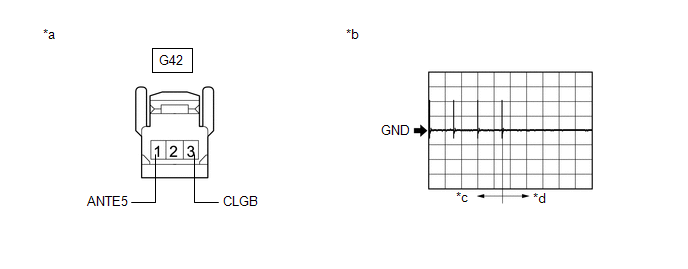
|
*a | Front view of wire harness connector (to No. 1 Indoor Electrical Key Antenna Assembly (Front Floor)) |
*b | Waveform |
|
*c | For 30 seconds after closing any door |
*d | After 30 seconds or more have elapsed since any door closed |
OK:
|
Tester Connection | Condition |
Tool Setting | Specified Condition |
|---|---|---|---|
|
G42-1 (ANTE5) - G42-3 (CLGB) |
Procedure:
| 2 V/DIV., 500 ms/DIV. |
Pulse generation (See waveform) |
| OK |  | REPLACE NO. 1 INDOOR ELECTRICAL KEY ANTENNA ASSEMBLY (FRONT FLOOR) |
| NG |  | REPLACE CERTIFICATION ECU (SMART KEY ECU ASSEMBLY) |
| 6. |
CHECK WAVE ENVIRONMENT |
(a) Install the transmitter battery to the electrical key transmitter sub-assembly.
Click here 
(b) Bring the electrical key transmitter sub-assembly near the No. 1 indoor electrical key antenna assembly (rear floor) and perform an smart key system check.
Click here 
NOTICE:
Communication may not be possible if the electrical key transmitter sub-assembly is within 0.2 m (0.656 ft.) of the center of the No. 1 indoor electrical key antenna assembly (rear floor).
HINT:
Check that the customize setting "Ignition Available Area" is set to "All".
HINT:
OK:
The engine starts when the electrical key transmitter sub-assembly is held near each indoor electrical key antenna assembly and the engine switch is pressed with the brake pedal depressed.
| OK |  | AFFECTED BY WAVE INTERFERENCE |
|
| 7. |
CHECK KEY DIAGNOSTIC MODE |
(a) Check the following antennas in key diagnostic mode.
| (b) Check the No. 1 indoor electrical key antenna assembly (rear floor). When the electrical key transmitter sub-assembly is at either inspection point, check that the wireless buzzer sounds. HINT:
|
|
|
Result | Proceed to |
|---|---|
|
The wireless buzzer does not sound |
A |
| The wireless buzzer sounds |
B |
| B |
 | AFFECTED BY WAVE INTERFERENCE |
|
| 8. |
CHECK HARNESS AND CONNECTOR (CERTIFICATION ECU (SMART KEY ECU ASSEMBLY) - NO. 1 INDOOR ELECTRICAL KEY ANTENNA ASSEMBLY (REAR FLOOR)) |
(a) Disconnect the K10 certification ECU (smart key ECU assembly) connector.
(b) Disconnect the K12 No. 1 indoor electrical key antenna assembly (rear floor) connector.
(c) Measure the resistance according to the value(s) in the table below.
Standard Resistance:
|
Tester Connection | Condition |
Specified Condition |
|---|---|---|
|
K10-5 (CLG6) - K12-1 (ANTE6) |
Always | Below 1 Ω |
|
K10-6 (CG6B) - K12-3 (CLGB) |
Always | Below 1 Ω |
|
K10-5 (CLG6) or K12-1 (ANTE6) - Other terminals and body ground |
Always | 10 kΩ or higher |
|
K10-6 (CG6B) or K12-3 (CLGB) - Other terminals and body ground |
Always | 10 kΩ or higher |
(d) Reconnect the K10 certification ECU (smart key ECU assembly) connector.
| NG |  | REPAIR OR REPLACE HARNESS OR CONNECTOR |
|
| 9. |
CHECK CERTIFICATION ECU (SMART KEY ECU ASSEMBLY) (OUTPUT TO NO. 1 INDOOR ELECTRICAL KEY ANTENNA ASSEMBLY (REAR FLOOR)) |
(a) Using an oscilloscope, check the waveform.
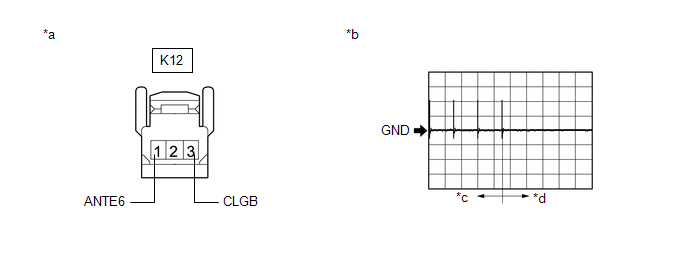
|
*a | Front view of wire harness connector (to No. 1 Indoor Electrical Key Antenna Assembly (Rear Floor)) |
*b | Waveform |
|
*c | For 30 seconds after closing any door |
*d | After 30 seconds or more have elapsed since any door closed |
OK:
|
Tester Connection | Condition |
Tool Setting | Specified Condition |
|---|---|---|---|
|
K12-1 (ANTE6) - K12-3 (CLGB) |
Procedure:
| 2 V/DIV., 500 ms/DIV. |
Pulse generation (See waveform) |
| OK |  | REPLACE NO. 1 INDOOR ELECTRICAL KEY ANTENNA ASSEMBLY (REAR FLOOR) |
| NG |  | REPLACE CERTIFICATION ECU (SMART KEY ECU ASSEMBLY) |
| 10. |
INSPECT TRANSMITTER BATTERY |
(a) Check the transmitter battery level of the electrical key transmitter sub-assembly that was checked first.
(1) Press and hold the lock switch of the electrical key transmitter sub-assembly for 5 seconds and check the number of times that the LED illuminates.
HINT:
Click here 
|
Result | Proceed to |
|---|---|
|
LED illuminates 3 times or more when switch is pressed and held |
A |
| LED does not illuminate when switch is pressed and held |
B |
| LED illuminates once or twice but not a third time |
C |
| B |
 | GO TO STEP 19 |
| C |
 | REPLACE TRANSMITTER BATTERY |
|
| 11. |
CHECK ENTRY LOCK / UNLOCK OPERATION |
(a) Check that the entry lock and unlock functions operate on each door.
Click here 
HINT:
If the door control receiver is defective, code verification does not begin in the cabin and the entry lock and unlock functions do not operate.
|
Result | Proceed to |
|---|---|
|
Entry functions operate normally for all doors (w/ Wireless Charging System) |
A |
| Entry functions operate normally for all doors (w/o Wireless Charging System) |
B |
| An entry function does not operate normally for a door |
C |
| B |
 | GO TO STEP 13 |
| C |
 | GO TO SMART KEY SYSTEM (for Entry Function, Gasoline Model) (All Door Entry Lock/Unlock Functions and Wireless Functions do not Operate) |
|
| 12. |
CHECK WIRELESS CHARGING SYSTEM |
(a) Wireless charging system off.
Click here 
(b) Check that interior verification is performed.
Click here 
|
Result | Proceed to |
|---|---|
|
Interior verification is not performed normally |
A |
| Interior verification is performed normally |
B |
| B |
 | GO TO WIRELESS CHARGING SYSTEM |
|
| 13. |
READ VALUE USING TECHSTREAM (START SWITCH1, START SWITCH2) |
(a) Connect the Techstream to the DLC3.
(b) Turn the engine switch on (IG).
(c) Turn the Techstream on.
(d) Enter the following menus: Body Electrical / Power Source Control / Data List.
(e) Read the Data List according to the display on the Techstream.
Body Electrical > Power Source Control > Data List|
Tester Display | Measurement Item |
Range | Normal Condition |
Diagnostic Note |
|---|---|---|---|---|
|
Start Switch1 | Engine switch 1 status |
OFF or ON | OFF: Engine switch not pressed ON: Engine switch pressed |
|
| Start Switch2 |
Engine switch 2 status |
OFF or ON | OFF: Engine switch not pressed ON: Engine switch pressed |
|
|
Tester Display |
|---|
| Start Switch1 |
|
Start Switch2 |
OK:
The value of "Start Switch1" and "Start Switch2" change correctly in response to the engine switch operation.
| NG |  | GO TO STEP 17 |
|
| 14. |
CHECK CERTIFICATION ECU (SMART KEY ECU ASSEMBLY) |
(a) Measure the voltage while checking the Data List on the Techstream.
(1) Connect the Techstream to the DLC3.
(2) Turn the engine switch on (IG).
(3) Turn the Techstream on.
(4) Enter the following menus: Body Electrical / Power Source Control / Data List.
(5) Read the Data List according to the display on the Techstream.

|
*a | Component with harness connected (Certification ECU (Smart Key ECU Assembly)) |
- | - |
|
Tester Display | Measurement Item |
Range | Normal Condition |
Diagnostic Note |
|---|---|---|---|---|
|
Power Supply Condition |
Power supply state | All OFF, ACC ON, IG ON or ST ON |
All OFF: Engine switch off (ACC and IG) ACC ON: Engine switch on (ACC) IG ON: Engine switch on (IG) ST ON: Sending engine start request signal |
- |
|
Tester Display |
|---|
| Power Supply Condition |
(6) Measure the voltage according to the value(s) in the table below.
Standard Voltage:
|
Tester Connection | Condition |
Specified Condition |
|---|---|---|
|
G40-17 (IG1D) - Body ground |
Engine switch off | Below 1 V |
|
Engine switch on (ACC) |
Below 1 V | |
|
Engine switch on (IG) |
9 V or higher | |
|
G40-16 (ACCD) - Body ground |
Engine switch off | Below 1 V |
|
Engine switch on (ACC) |
8.5 V or higher | |
|
Engine switch on (IG) |
8.5 V or higher |
| NG |  | REPLACE CERTIFICATION ECU (SMART KEY ECU ASSEMBLY) |
|
| 15. |
CHECK INSTRUMENT PANEL JUNCTION BLOCK ASSEMBLY (IG1-NO. 1, IG1-NO. 2, IG2-NO. 2, ACC RELAY) |
(a) Remove the instrument panel junction block assembly.
Click here

(b) Connect all of the instrument panel junction block assembly connectors.
(c) Measure the voltage according to the value(s) in the table below.
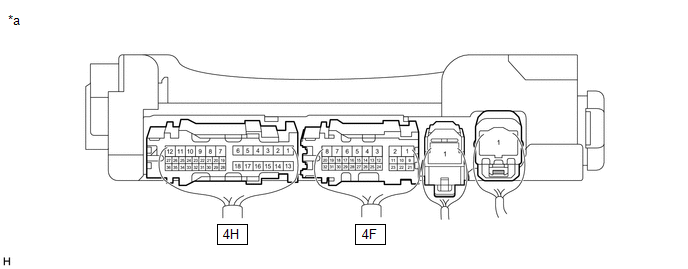
|
*a | Component without harness connected (Instrument Panel Junction Block Assembly) |
- | - |
Standard Voltage:
|
Tester Connection | Condition |
Specified Condition |
|---|---|---|
|
4H-26 - Body ground | Engine switch on (ACC) |
11 to 14 V |
|
4H-35 - Body ground | Engine switch on (IG) |
11 to 14 V |
|
4F-2 - Body ground | Engine switch on (IG) |
11 to 14 V |
|
4F-15 - Body ground | Engine switch on (IG) |
11 to 14 V |
| OK |  | REPLACE CERTIFICATION ECU (SMART KEY ECU ASSEMBLY) |
|
| 16. |
CHECK HARNESS AND CONNECTOR (INSTRUMENT PANEL JUNCTION BLOCK ASSEMBLY - BODY GROUND) |
(a) Disconnect the 4D instrument panel junction block assembly connector.
(b) Measure the resistance according to the value(s) in the table below.
Standard Resistance:
|
Tester Connection | Condition |
Specified Condition |
|---|---|---|
|
4D-3 - Body ground | Always |
Below 1 Ω |
| OK |  | REPLACE INSTRUMENT PANEL JUNCTION BLOCK ASSEMBLY |
| NG |  | REPAIR OR REPLACE HARNESS OR CONNECTOR |
| 17. |
INSPECT ENGINE SWITCH |
(a) Remove the engine switch.
Click here 
(b) Inspect the engine switch.
Click here 
| NG |  | REPLACE ENGINE SWITCH |
|
| 18. |
CHECK HARNESS AND CONNECTOR (CERTIFICATION ECU (SMART KEY ECU ASSEMBLY) - ENGINE SWITCH) |
(a) Disconnect the G40 certification ECU (smart key ECU assembly) connector.
(b) Measure the resistance according to the value(s) in the table below.
Standard Resistance:
|
Tester Connection | Condition |
Specified Condition |
|---|---|---|
|
G40-23 (SSW1) - G41-5 (SS1) |
Always | Below 1 Ω |
|
G40-21 (SSW2) - G41-1 (SS2) |
Always | Below 1 Ω |
|
G40-11 (AGND) - G41-6 (AGND) |
Always | Below 1 Ω |
|
G40-23 (SSW1) or G41-5 (SS1) - Other terminals and body ground |
Always | 10 kΩ or higher |
|
G40-21 (SSW2) or G41-1 (SS2) - Other terminals and body ground |
Always | 10 kΩ or higher |
|
G40-11 (AGND) or G41-6 (AGND) - Other terminals and body ground |
Always | 10 kΩ or higher |
| OK |  | REPLACE CERTIFICATION ECU (SMART KEY ECU ASSEMBLY) |
| NG |  | REPAIR OR REPLACE HARNESS OR CONNECTOR |
| 19. |
INSPECT TRANSMITTER BATTERY |
(a) Inspect the transmitter battery.
Click here 
NOTICE:
Do not wrap the lead wire ground a terminal, wedge it between terminals, or solder it. The terminal may be deformed or damaged, and the transmitter battery will not be able to be installed correctly.
| OK |  | REPLACE ELECTRICAL KEY TRANSMITTER SUB-ASSEMBLY |
| NG |  | REPLACE TRANSMITTER BATTERY |
Toyota Avalon (XX50) 2019-2022 Service & Repair Manual > Hybrid Control System: Drive Motor "A" Control Module Internal Electronic Failure (P0A1B49). Drive Motor "A" Control Module Unexpected Operation (P0A1B94). Drive Motor "A" Temperature Sensor Voltage Out of Range (P0A2A1C,P0
Drive Motor "A" Control Module Internal Electronic Failure (P0A1B49) DESCRIPTION The motor generator control ECU (MG ECU), which is built into the inverter with converter assembly, monitors its internal operation and will store DTCs if the system is malfunctioning. DTC No. Detection Item DTC Detecti ...